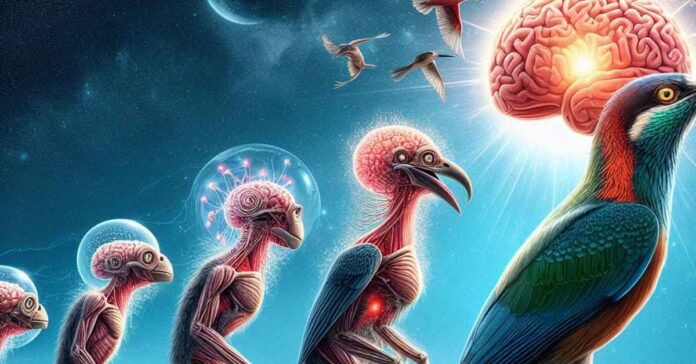Evolutionary biologists at Johns Hopkins Medicine have unveiled groundbreaking insights into the evolution of bird brains, shedding light on the long-standing mystery of how avian brains adapted for flight.
Their research, published in the Proceedings of the Royal Society B, reveals a crucial link between the cerebellum and the ability to fly.
Flight and Brain Evolution
The study, led by Dr. Amy Balanoff, delves into the unique neurobiological adaptations that facilitated powered flight in birds.
By combining PET scans of modern pigeons with analyses of dinosaur fossils, researchers identified a significant increase in cerebellum size in fossil vertebrates, suggesting its pivotal role in avian flight.
Unraveling Ancient Mysteries
Through meticulous examination of both modern avian brains and fossilized dinosaur endocasts, the research team traced the evolution of flight-enabled brains back to early maniraptoran dinosaurs.
Their findings underscore the intricate relationship between brain morphology and locomotive abilities, offering unprecedented insights into avian evolution.
The Cerebellum’s Role
PET imaging scans revealed a consistent increase in cerebellar activity during flight in modern pigeons, highlighting the cerebellum’s indispensable role in orchestrating complex aerial maneuvers.
This neurological phenomenon, coupled with evidence of cerebellar expansion in ancient maniraptorans, suggests a convergent evolution of flight-enabled brains across avian species.
Optic Flow Pathways
Furthermore, the study uncovered heightened activity in optic flow pathways, crucial for processing visual information during flight.
This discovery reinforces the interconnectedness of sensory perception and motor control in avian flight, emphasizing the multifaceted nature of brain adaptations in aerial locomotion.
Future Directions
While the research marks a significant breakthrough, scientists acknowledge the need for further investigation into the precise neural mechanisms underlying flight readiness.
Future endeavors will focus on mapping specific cerebellar regions involved in flight control and elucidating neural circuitry governing avian locomotion.
Implications for Evolutionary Biology
Dr. Gabriel Bever underscores the broader implications of these findings, suggesting that the evolutionary expansion of the brain may have facilitated the exploration of new ecological niches, ultimately paving the way for the emergence of flight.
At Johns Hopkins, interdisciplinary collaboration and cutting-edge technology converge to unravel the mysteries of evolutionary history.
Conclusion
In unraveling the evolutionary secrets of bird brains, researchers at Johns Hopkins Medicine have illuminated the intricate interplay between neurobiology and locomotion.
By bridging the gap between modern avian physiology and ancient fossil records, this study offers a compelling narrative of adaptation and innovation in the quest for flight.
FAQ
Evolutionary biologists at Johns Hopkins Medicine utilized a combination of PET scans of modern pigeons and analyses of dinosaur fossils. By comparing brain activity during flight in pigeons and examining fossilized endocasts of ancient dinosaurs, researchers identified key neurobiological adaptations associated with flight.
Optic flow pathways are networks of brain cells that process visual information related to movement across the visual field. In bird flight, these pathways play a crucial role in guiding navigation and spatial awareness, highlighting their significance in aerial locomotion.
More information: Quantitative functional imaging of the pigeon brain: implications for the evolution of avian powered flight, Proceedings of the Royal Society B: Biological Sciences (2024). DOI: 10.1098/rspb.2023.2172. royalsocietypublishing.org/doi … .1098/rspb.2023.2172

